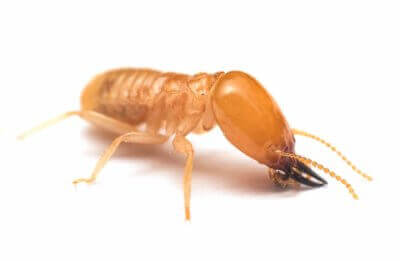Termite Facts & Information
Everything you need to know about termites
WHAT DO termites LOOK LIKE

Subterranean termites are social insects that live in colonies within the ground and have specialized castes to perform specific colony functions. The termite colony has three primary castes: workers, soldiers, and the reproductives (kings, queens, and secondaries). The workers are creamy white and seldom seen unless a termite tube or infested wood is broken open. It’s the workers that feed on the wood and therefore the ones causing the damage.
Individual workers are believed to survive for up to five years. Soldiers have elongated yellowish heads with large jaws and are about the same size as the adult worker, about a quarter inch. There are fewer soldiers than their associated workers and they fully rely on the workers to feed them.
Whenever the colony is invaded or a hole is made in a tube or piece of infested wood, the soldiers will use their jaws to defend the breach. The secondaries are supplementary reproductive females that occur in mature colonies under favorable conditions. The kings and queens are dark-brown or black and about 3/8 to 1/2 inch long. They have two pairs of translucent wings of equal length, which break off shortly after swarming. Very often the shed wings are the only evidence that termites are around. They swarm when their current colony is large enough to warrant another. During late winter or early spring, swarms of the reproductive caste may be noticed in infested buildings. These black, winged termites are the stage most commonly seen, since the other castes do not willingly expose themselves to light. Winged termites are attracted to light, and when they emerge within buildings, they swarm about doors and windows. After crawling or fluttering about for a short time, the termites break off their wings and locate a mate. Each pair attempts to locate moist wood in contact with the soil to start a new colony, but few succeed. Although they can be a nuisance, no damage is done by the winged forms. If you see a swarm happening, odds are you have current termite damage.
Individual workers are believed to survive for up to five years. Soldiers have elongated yellowish heads with large jaws and are about the same size as the adult worker, about a quarter inch. There are fewer soldiers than their associated workers and they fully rely on the workers to feed them.
Whenever the colony is invaded or a hole is made in a tube or piece of infested wood, the soldiers will use their jaws to defend the breach. The secondaries are supplementary reproductive females that occur in mature colonies under favorable conditions. The kings and queens are dark-brown or black and about 3/8 to 1/2 inch long. They have two pairs of translucent wings of equal length, which break off shortly after swarming. Very often the shed wings are the only evidence that termites are around. They swarm when their current colony is large enough to warrant another. During late winter or early spring, swarms of the reproductive caste may be noticed in infested buildings. These black, winged termites are the stage most commonly seen, since the other castes do not willingly expose themselves to light. Winged termites are attracted to light, and when they emerge within buildings, they swarm about doors and windows. After crawling or fluttering about for a short time, the termites break off their wings and locate a mate. Each pair attempts to locate moist wood in contact with the soil to start a new colony, but few succeed. Although they can be a nuisance, no damage is done by the winged forms. If you see a swarm happening, odds are you have current termite damage.
Where Do Termites Live
The most prominent termite in Massachusetts, Connecticut, New York, Maine, Vermont, New Hampshire, and Rhode Island is the eastern subterranean termite. These termites often damage structural timbers in buildings. When this damage becomes evident, it’s usually the result of years of infestation. Thus, damage by termites is not a sudden onslaught that will cause a building to collapse in a few days. Generally, termite problems only occur some years after construction. The risk of infestations can be reduced by avoiding certain faults or errors in construction, site grading and maintenance, or proactive baits that catch termites early – before they can do the damage.
Termites feed upon old roots, tree stumps, fallen tree limbs and branches on the ground, and similar materials. They are beneficial when they aid in reduction of wood and similar cellulose products into compounds that can be used again by other living organisms. Occasionally termites attack living plants, including the roots of shrubs and trees. In buildings, they feed on cellulose materials, such as structural wood, wood fixtures, paper, books, cotton, and related products.
Termites feed upon old roots, tree stumps, fallen tree limbs and branches on the ground, and similar materials. They are beneficial when they aid in reduction of wood and similar cellulose products into compounds that can be used again by other living organisms. Occasionally termites attack living plants, including the roots of shrubs and trees. In buildings, they feed on cellulose materials, such as structural wood, wood fixtures, paper, books, cotton, and related products.
How Did I Get Termites
Most termite infestations occur in the basement or cellar areas and in the structural timbers immediately above the cellar walls, such as the mudsills, studs, joists, subflooring, and floors. Wooden posts, steps, door frames, and trim embedded in an earth or concrete floor are especially susceptible to termite infestation. Wood siding, window frames, steps, and similar materials covered by earth or resting on the ground may also be attacked by termites. Where the termite infestation is extensive, the flooring and framework in the walls can be damaged by termites. This usually happens where houses are built on concrete slabs. Termites especially favor areas around furnaces, chimneys, hot water heaters, and hot water pipes that provide warmth during cold months.
All woodwork in suspect areas should be probed for soundness and visually inspected for any sign of mud tunnels. An awl, ice pick, screwdriver, or similar instrument is commonly used to probe the wood. After the area and extent of infestation are determined, control measures can be planned.
Wood attacked by termites has runways or passages that are coated with an earth-like material glued to the wood. Where the wood has been infested for some time, it may be largely hollowed out with passages and may be rotten in appearance. Upon probing such wood with a screwdriver or similar tool, many of the hidden worker termites may spill out. If you’re buying a house, be sure to get a WDIR (wood destroying insect report) so you know what you’re getting into and possibly what house to pass on.
All woodwork in suspect areas should be probed for soundness and visually inspected for any sign of mud tunnels. An awl, ice pick, screwdriver, or similar instrument is commonly used to probe the wood. After the area and extent of infestation are determined, control measures can be planned.
Wood attacked by termites has runways or passages that are coated with an earth-like material glued to the wood. Where the wood has been infested for some time, it may be largely hollowed out with passages and may be rotten in appearance. Upon probing such wood with a screwdriver or similar tool, many of the hidden worker termites may spill out. If you’re buying a house, be sure to get a WDIR (wood destroying insect report) so you know what you’re getting into and possibly what house to pass on.
What Problems Do Termites Cause
The extent of damage to structural timbers and woodwork can be determined by a careful inspection of the building. Property damage from termites exceeds $5 billion per year in just the U.S. alone. In addition, because there are preventative termite treatments out there, most homeowner’s insurance policies don’t cover the damage caused. If left unchecked, the damage to your wallet is more extensive than the damage to your property. Although if the damage has been done to your home, the sentimental and practical value is immeasurable. Subterranean termites dwell underground in loose, damp soil. Although subterranean termite species in Africa are famously aggressive and known for the obvious mounds above their colonies, signs of subterranean termite damage within the United States are much less obvious.
Interior damage may not become apparent until infestations are full-blown. Termite damage sometimes appears similar to water damage. Outward signs of termite damage include buckling wood, swollen floors and ceilings, areas that appear to be suffering from slight water damage, and visible mazes within walls or furniture. Termite infestations also can exude a scent similar to mildew or mold.
Interior damage may not become apparent until infestations are full-blown. Termite damage sometimes appears similar to water damage. Outward signs of termite damage include buckling wood, swollen floors and ceilings, areas that appear to be suffering from slight water damage, and visible mazes within walls or furniture. Termite infestations also can exude a scent similar to mildew or mold.
How Can I Prevent Termites
Identification is key. Winged termites are often confused with winged ants. Most species of ants in the house are only nuisances with the exception of carpenter ants which can damage wood. For this reason, it’s especially important to know the differences between winged termites and winged ants. The easiest way to distinguish the two groups is to look at their waists. An ant has a narrow, wasp-like waist; a termite has a broad waist. The antennae or feelers of ants are L-shaped, whereas those of termites are straight. Furthermore, the four wings of termites are of equal length and nearly twice as long as the termite body, while ant wings are approximately equal to the length of the ant, and the fore and hind wings are of unequal length.
The best way to prevent termites and the damage they cause is a professional proactive baiting system that will catch them as early as possible. There are no successful DIY termite treatments and learning that can cost you.
The best way to prevent termites and the damage they cause is a professional proactive baiting system that will catch them as early as possible. There are no successful DIY termite treatments and learning that can cost you.
Why Waltham for Termite Control
We’re passionate about keeping termites out of your home or business because we live and work here – it’s our neighborhood, too. With our 130 years of experience keeping homes and businesses in Massachusetts, Connecticut, New York, Maine, Vermont, New Hampshire, and Rhode Island safe from pests, Waltham has the experience you can trust.
Satisfaction Guarantee
24-Hour Guaranteed Response
Board Certified Entomologists
Consider termites controlled.
GET MY QUOTE
“Exceptional service. Prompt and professional. Used for both business and home. Very efficient and honest.”
Agawan, MA
